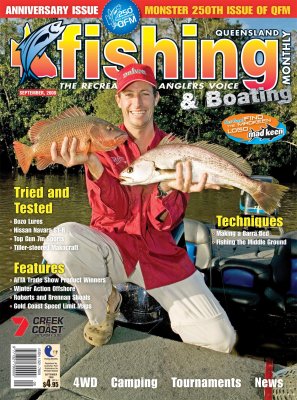Operation Middle Ground: A Battle Plan for Targeting Shoal Dwellers by Lee Brake
 When heading for an offshore fishing trip, the weather will usually dictate two options: a scoot to the reef in fair conditions, or island hop to rocky headlands in rough conditions. But what about those neutral days, when the sea is unpredictable, and a 'little breeze' suddenly turns the boat into a seesaw? Do you scoot or hop? My answer is to do neither, instead fish the middle ground.
When heading for an offshore fishing trip, the weather will usually dictate two options: a scoot to the reef in fair conditions, or island hop to rocky headlands in rough conditions. But what about those neutral days, when the sea is unpredictable, and a 'little breeze' suddenly turns the boat into a seesaw? Do you scoot or hop? My answer is to do neither, instead fish the middle ground.
So what is the middle ground? To put it simply, it's shoaly areas, bits of low growing soft corals and rubble patches that usually exist close enough to the mainland or an island to be protected from a wind increase. The supreme feature of such places is that they are often under-fished and can contain large populations of schooling species.
RESEARCH AND RECONNAISSANCE
First thing to do before heading out is to purchase a local marine chart (or a GPS map card) and look for any contour lines that indicate a rise in sea level. As a general rule most decent rises will be already marked and named. But be aware that contours named as 'Something' Shoals, will generally be mere sand hills or sandy ridgelines that hold little structure. However, some of these empty shoals can sometimes produce interesting pressure waves and can at times hold bait, so it is always worth a troll around their edges with fast running lures like Rapala Magnums, Laser Pros and Tremblers.
Even though most shoals are sand, be sure to still go over them with the depth sounder. Any density in the bottom line can indicate low grown corals or rubble, which are well worth a fish. The best way to check is to simply throw out a reef-pick and drag it over the bottom; a reasonably experienced fisher can quickly make out the seabed's consistency. The anchor will also serve to slow down the boat's drift making this a perfect time for drift fishing. Many snapper, red emperor and sweetlip are caught in this fashion.
Nevertheless, a better prospect is to look for areas off the beaten track marked as 'Something' Rock. These spots will almost always contain large amounts of structure, but they will often also attract large numbers of boats. The trick can often be to find the rock's fringe areas, as these will often be in much deeper water, be rubble and hold numbers of quality table fish.
Many of these small rubble patches and minor coral areas are unmarked so, while it is a gamble, it can often pay to do some drift fishing in deep areas (30m+) near your favourite island or reef. Always keep one eye on your sounder and remember to mark any interesting structure on your GPS. These marks can end up being more precious than a corporate box at the State of Origin.